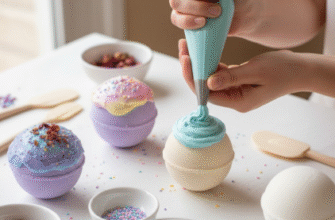Tired of eyeshadows packed with ingredients you can barely pronounce? Or maybe you just adore that subtle, barely-there wash of color that enhances your eyes without screaming “makeup!”? Creating your own natural cream eyeshadow is surprisingly simple and lets you control exactly what goes onto your delicate eyelid skin. Plus, it’s a fantastic way to achieve those soft, blendable, natural hues that look effortlessly chic. Forget chalky powders or overly shimmery creams from the store; let’s dive into crafting your own little pot of subtle perfection.
Making your own cosmetics might sound intimidating, but cream eyeshadow is one of the easiest places to start. It requires just a few natural ingredients, minimal equipment, and a little bit of patience. The result? A creamy, nourishing shadow that glides on smoothly and provides a gentle hint of color. It’s perfect for everyday wear, for those who prefer a minimalist look, or even as a base for powder eyeshadows if you want to intensify the color later.
Why Go DIY for Cream Eyeshadow?
There are so many compelling reasons to whip up your own eyeshadow. Firstly, ingredient control is paramount. You know exactly what’s in your product – no hidden synthetics, harsh preservatives, or questionable fillers. If you have sensitive skin or allergies, this is a game-changer. You can choose ingredients known for their gentleness and nourishing properties.
Secondly, customization is key. You are the color artist! While we’re focusing on subtle shades here, you can tweak the amounts of natural pigments to get the precise soft beige, gentle rose, muted brown, or faint peach you’ve been dreaming of. Store-bought shades are often limited, but with DIY, your perfect subtle hue is achievable.
Thirdly, it can be incredibly cost-effective in the long run. While there’s an initial investment in some base ingredients like shea butter or mica powders, these ingredients go a very long way and can be used for numerous batches of eyeshadow or even other DIY beauty products like lip balm or body butter. Compare that to the price of a single high-end cream eyeshadow!
And finally, let’s be honest – it’s fun and rewarding! There’s a certain satisfaction in creating something beautiful and useful with your own hands, using natural elements. It connects you more deeply to the products you use daily.
The Basic Creamy Base Recipe
This recipe forms the foundation of your eyeshadow. It’s designed to be smooth, blendable, and relatively stable at room temperature. You can easily scale it up or down depending on how much you want to make.
Ingredients for the Base:
- 1 teaspoon Shea Butter (nourishing and creamy)
- 1 teaspoon Coconut Oil (provides glide, ensure it’s fractionated if you live in a very warm climate to prevent melting, or use jojoba oil as an alternative)
- 1/2 teaspoon Beeswax pellets or Candelilla wax (for firmness – use Candelilla for a vegan option)
- A tiny drop (literally, just a touch) of Vitamin E oil (acts as a mild preservative and antioxidant)
Equipment You’ll Need:
- A small heatproof glass bowl or beaker
- A small saucepan (for a double boiler setup)
- A small spatula or stirring stick (wood or silicone works well)
- A clean, small pot or tin with a lid for storage (like an old lip balm tin or a small cosmetic jar)
Adding Subtle, Natural Color
This is where the magic happens! Achieving subtle color means adding your chosen pigment very sparingly. Remember, you can always add more, but you can’t take it out once it’s mixed in. Always, always use cosmetic-grade pigments that are specifically approved for use on the eyes. Craft store glitter or food colorings are not safe!
Natural Pigment Ideas for Subtle Hues:
- Cosmetic Mica Powders: These are your best bet for reliable, safe, and varied colors. Look for finely milled, plain micas in shades like soft gold, bronze, beige, rose gold, or muted pinks and browns. Start with just a tiny pinch (like 1/16th of a teaspoon or even less) per batch of base.
- Natural Clays: Kaolin clay can lighten and provide a matte base. French green clay (use sparingly!) can give a very subtle green hint. Rose kaolin clay can offer a soft pinkish tone. Ensure they are cosmetic grade.
- Cocoa Powder: Unsweetened cocoa powder can create lovely soft brown shades. Start with a tiny amount for a subtle taupe. Ensure it’s pure cocoa, not a drinking chocolate mix.
- Beetroot Powder: Can lend a very faint pink or reddish hue. Use extremely sparingly as it can be potent. Must be cosmetic grade and finely sifted.
- Spirulina Powder: For a potential subtle green/teal hint, again, use an minuscule amount and ensure it’s cosmetic grade.
- Activated Charcoal: A minuscule speck can create a soft grey or deepen other colors slightly. Be incredibly cautious with this near the eyes and use only cosmetic grade.
Important Safety Note: Always source pigments from reputable cosmetic ingredient suppliers. Ensure they explicitly state ‘eye-safe’ or ‘approved for cosmetic use on eyes’. Never use spices (like turmeric or paprika), craft glitters, or non-cosmetic grade powders, as these can cause severe irritation or injury. Always perform a patch test on your inner arm 24-48 hours before applying any DIY cosmetic near your eyes, especially if using plant-based powders.
Step-by-Step: Making Your Eyeshadow
Ready to create? Here’s how you bring it all together:
- Prepare Your Workspace: Cleanliness is crucial. Make sure your hands, equipment, and storage container are thoroughly cleaned and dried. You might want to wipe down surfaces and tools with rubbing alcohol for extra sanitation.
- Set Up Double Boiler: Fill your small saucepan with about an inch of water and bring it to a gentle simmer. Place your heatproof glass bowl on top, ensuring the bottom doesn’t touch the water.
- Melt Base Ingredients: Add the shea butter, coconut oil (or alternative), and beeswax/candelilla wax to the glass bowl. Allow them to melt slowly and gently over the simmering water, stirring occasionally with your clean spatula until completely liquid and combined.
- Remove from Heat: Once everything is melted and homogenous, carefully remove the bowl from the heat. Be cautious, as the bowl will be hot.
- Add Vitamin E: Stir in the tiny drop of Vitamin E oil.
- Incorporate Color (The Subtle Part!): This is the crucial step for subtlety. Take out a tiny amount of your chosen cosmetic-grade pigment (start with less than you think you need – maybe 1/16 tsp or a tiny scoop on the end of your spatula). Add it to the melted base oils/wax.
- Mix Thoroughly: Stir, stir, stir! You need to ensure the pigment is fully dispersed throughout the mixture. Scrape the sides and bottom of the bowl to incorporate everything evenly. If the mixture starts to solidify too quickly, you can briefly place it back over the warm water (off the direct heat) to loosen it up again, but avoid overheating. Keep mixing until the color is uniform and there are no streaks or clumps of pigment.
- Check the Color: Dab a tiny amount onto the back of your hand or a piece of white paper to check the color intensity. Is it subtle enough? If you want slightly more color, add another minuscule pinch of pigment and mix thoroughly again. Remember the goal is subtle!
- Pour into Container: Carefully pour the liquid eyeshadow mixture into your clean, small storage pot or tin.
- Cool and Set: Leave the container open and undisturbed at room temperature for several hours (or pop it in the fridge for about 15-30 minutes) until the cream eyeshadow is completely solidified. Once set, secure the lid.
Tips for Application and Use
Applying your homemade cream eyeshadow is easy. Use a clean fingertip or a dense, flat synthetic brush. Gently swirl your finger/brush in the pot to pick up a small amount of product – a little goes a long way. Pat the color onto your eyelid, starting near the lash line and blending upwards. For a subtle look, focus the color near the lashes and blend it out softly towards the crease. You can layer it slightly for a bit more intensity, but the beauty of this recipe is its natural, sheer finish. Because it contains oils, it will have a slightly dewy finish rather than a matte, powdery look.
Blending is key for a natural effect. Use your fingertip or a clean blending brush to soften any harsh edges. The warmth of your skin helps the product melt in beautifully. This type of shadow is less about precision lines and more about a soft wash of enhancing color.
Storage and Shelf Life
Store your DIY natural cream eyeshadow in a cool, dark place with the lid tightly sealed. Because it contains natural oils and lacks strong commercial preservatives, its shelf life is shorter than store-bought products. Generally, aim to use it within 3-6 months. Always practice good hygiene: apply with clean fingers or brushes, never introduce water into the pot, and discard immediately if you notice any change in smell, color, or texture, or if it causes any irritation.
Verified Tip: Using fractionated coconut oil (which stays liquid) instead of regular coconut oil can help prevent graininess if your regular coconut oil tends to solidify unevenly in cooler temperatures. Alternatively, jojoba oil is an excellent choice as its composition is very similar to human sebum, making it readily absorbed and less likely to cause issues in varying temperatures. Both are great options for a smooth final product.
Creating your own subtle cream eyeshadow is a delightful way to embrace natural beauty and get creative. You get a product tailored perfectly to your preferences, made with ingredients you trust. Enjoy the process and the beautifully understated results!








